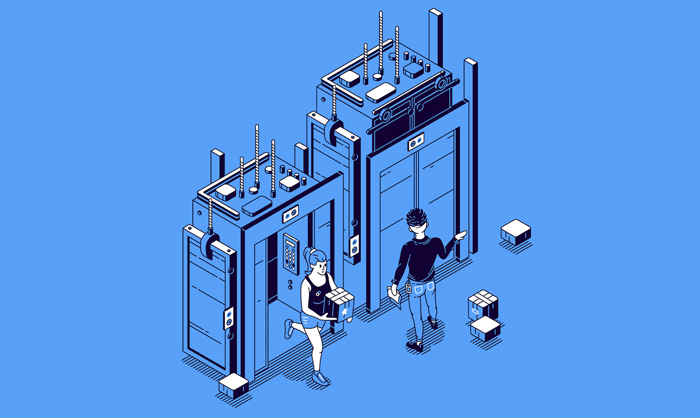From controllers and signal fixtures to cylinders and cables, there are many parts that go into the composition of an elevator. Let’s go over the basic elevator components and what they all mean today.

A Look at Common Elevator Components
- Cabin or Car: The main part of the elevator, designed for enclosed transport of passengers and goods.
- Cable (Rope): Designed to support and pull the car.
- Elevator Machine: A traction machine used on traction elevator equipment types consisting of a motor, brake, drive sheave, and machine bed plate. The traction machine motor is responsible for turning the drive sheave shaft, which then turns the drive sheave. When the sheave starts to turn, those hoist ropes then go over the sheave, pulling the cars throughout the hoistway.
- Controller: This controls the elevators, whether you have a manual or automatic one.
- Drive unit: Anything that works under electricity needs a motor attached for function. Also known as the elevator’s control system, this is what controls up and down movement. You will find it in the elevator machine room and it comprises the motor, control system, and drive system for safe operation of the elevator.
- Counterweight: A heavy counterweight weighs about the same amount as the car when loaded; in essence, when the elevator rise, the counterweight goes down, and vice versa. This action makes it easier for the motor to lower and raise the car, putting less strain on the cables and reducing the amount of energy needed by the motor.
- Hoistway: This is the space enclosed by elevator doors and fireproof walls, including the pit.
- Handrails: These are designed to support passengers, but they also protect the cab walls from damage by luggage, backpacks or carts.
- Guide Rails: These are steel T-shaped or formed sections featuring guiding surfaces that are installed vertically within a hoistway to direct the course of travel of the car.
- Buffers: This is found at the bottom of the elevator, and its purpose is to protect people by stopping a descending car through the accumulation or dissipation of the car’s kinetic energy.
- Speed governors: This is a separate speed-regulating system, basically a flywheel with mechanical arms inside.
- Safety brake: In the event the cable snaps, which is extremely unlikely, this will prevent the car from crashing.
- Doors: Designed for entry and exit, there are two types of elevator doors: manual and automatic.
- Wall panels: Available in many shapes, arrangements, and finishes, the most common materials are stainless steel, laminate, or mirror. Installed on top of the base, the wall panel edges are called trims, with the areas between then being called reveals.
Contact Mowrey Elevator
Need new parts for your elevator? We have them! Check out our online catalog and contact us for more information.
